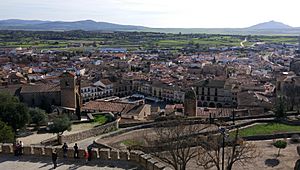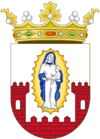Trujillo, Cáceres facts for kids
Quick facts for kids
Trujillo
|
||
|---|---|---|
 |
||
|
||
| Country | Spain | |
| Autonomous Community | Extremadura | |
| Province | Cáceres | |
| Area | ||
| • Total | 654.53 km2 (252.72 sq mi) | |
| Elevation
(AMSL)
|
564 m (1,850 ft) | |
| Population
(2018)
|
||
| • Total | 9,193 | |
| • Density | 14.0452/km2 (36.3769/sq mi) | |
| Time zone | UTC+1 (CET) | |
| • Summer (DST) | UTC+2 (CEST (GMT +2)) | |
| Postal code |
10200
|
|
| Area code(s) | +34 (Spain) + 927 (Cáceres) | |
| Website | www.trujillo.es | |
Trujillo is a town in Extremadura, a region in Spain. It is located in the Province of Cáceres. In 2013, about 9,086 people lived there. The town was first built on a rocky hill, which was easy to defend. Now, it has grown towards the southeast. Trujillo is a popular place for tourists and a market town for the area.
The older part of the town has many buildings from the Middle Ages and the Renaissance period. Every year, in early May, Trujillo hosts a big national cheese festival.
Contents
History of Trujillo
Trujillo was first settled a very long time ago, even before Roman times, on a large granite rock formation. When the Romans arrived, they called the town Turgalium. It was an important town that paid taxes to the capital city of Lusitania, which was called Emerita Augusta (now Mérida). Later, tribes from Eastern Europe, like the Visigoths, settled here. However, most people living there were still Hispano-Roman.
Islamic Rule and Reconquest
After the Islamic conquest of Spain around 711 AD, Trujillo became one of the main towns in the region. It was known as Turjaala in Arabic. This area was part of the Umayyad Emirate and later the Caliphate until the mid-11th century. During this time, different groups of people, like the Berbers and Arabs, sometimes had disagreements, which made the Caliphate weaker.
Later, a group called the Almoravids took over a large part of the area. Trujillo became a base for their raids against nearby lands in the early 12th century.
During the time of the Almohads, there were many wars with Portugal and the kingdoms of Castile and León. This meant that Trujillo often changed hands between these kingdoms and the Almohads. It returned to Muslim control for the last time in 1195. Between 1188 and 1195, it was the main base for a group of knights called the military order of Trujillo.

In 1196, with help from the Kingdom of León, the Almohads attacked the Tagus valley. They took over Santa Cruz and Trujillo, which had been left empty by the Order of Trujillo.
A Christian army, made up of military orders and the Bishop of Plasencia, surrounded Trujillo. Ferdinand III supported them. A Muslim leader named Muhammad ibn Hüd tried to help the town, but the Christian army stopped him.
The Christians finally captured Trujillo on January 25, 1232. A local story says that during the final attack, the Christian soldiers were about to give up. But then, many of them saw the Virgin Mary (known as Virgen de la Victoria, or the Virgin Mary of Victory) between two towers of the castle. This inspired them to keep fighting, and they won, defeating the Muslims inside.
Trujillo, along with Plasencia, Cáceres, and Coria, was one of the few important towns in the region that belonged directly to the king. Most other lands were controlled by military orders.
Growth and Explorers
In 1256, Alfonso X gave Trujillo a special set of laws called a fuero. Later, in 1430, John II officially made Trujillo a city. As the population grew, Trujillo expanded beyond its old city walls. There was also a Jewish quarter outside these strong medieval walls.
Many explorers from Trujillo, known as Trujillanos, traveled across the Atlantic Ocean to the Americas. When they returned, they built grand palaces near the main square, the Plaza Mayor. Most of these palaces can still be visited today. Francisco Pizarro, a famous explorer from Trujillo, came back and helped his family become very wealthy in the Plaza Mayor. His daughter, whose mother was an Incan princess, returned to Trujillo at age 17. She married her uncle and lived the rest of her life in Trujillo as an important lady.
After 1595, many 'new moriscos' (Muslims who had been forced to convert to Christianity) were moved to Trujillo from Granada. Between 1610 and 1611, about 130 morisco families were forced to leave Trujillo. However, some 'old moriscos' who had local support were allowed to stay.
During the War for Independence (1808-1814), the mayor of Trujillo, Antonio Martin Rivas, was one of the first to respond to the call for help. He gathered volunteers, food, and weapons to support the fight. The French army captured Trujillo in 1811 and held it until 1812.
In 1834, Trujillo became the official center for the local court system. In 1842, a count showed that the city had 110 households and 6,026 residents.
Geography
Climate
Trujillo has a hot-summer Mediterranean climate. This means it has hot, dry summers and mild, wet winters.
| Climate data for Trujillo (data for 1961–2001) | |||||||||||||
|---|---|---|---|---|---|---|---|---|---|---|---|---|---|
| Month | Jan | Feb | Mar | Apr | May | Jun | Jul | Aug | Sep | Oct | Nov | Dec | Year |
| Daily mean °C (°F) | 7.2 (45.0) |
8.7 (47.7) |
11.5 (52.7) |
13.6 (56.5) |
17.7 (63.9) |
22.6 (72.7) |
26.5 (79.7) |
26.2 (79.2) |
22.5 (72.5) |
16.6 (61.9) |
11.0 (51.8) |
7.6 (45.7) |
16.0 (60.8) |
| Average precipitation mm (inches) | 67.9 (2.67) |
70.4 (2.77) |
51.1 (2.01) |
60.6 (2.39) |
51.4 (2.02) |
33.0 (1.30) |
6.8 (0.27) |
9.6 (0.38) |
39.7 (1.56) |
64.6 (2.54) |
86.3 (3.40) |
81.6 (3.21) |
623.1 (24.53) |
| Source: Ministerio de Agricultura, Alimentación y Medio Ambiente. Datos de precipitación y de temperatura para el periodo 1961–2001 en Trujillo. | |||||||||||||
Ecology
Like many towns in Extremadura, Trujillo's old buildings are home to many storks that nest there. Other interesting birds include the Lesser kestrel, which builds nests in the bull-ring and other places around town.
Monuments and Museums
Trujillo has many important historical buildings and places. Some of the most famous are:
- The Castle (called the Alcazaba)
- The church of Santiago
- The church of Santa María la Mayor
- The church of San Francisco
- The Church of San Martín
- The Plaza Mayor (main square)
- Renaissance palaces like the palace of the Marquis of the Conquest, the palace of the Orellana-Pizarro family, and the palace of the Duques de San Carlos.
The Palacio de Piedras Albas was built around 1530. It was first owned by the Orellana Toledo family.
The city also has several museums, including:
- The Museum of Coria (Javier Salas Foundation)
- Pizarro's House (a museum about Francisco Pizarro)
- Enrique Elías Museum (about a local designer)
- The Museum of Cheese and Wine
Events and Festivals
The Chiviri Festival

This festival happens on Easter Sunday and is a very important event in the region. The town square fills with people wearing traditional local clothes. They sing, dance, eat, and drink to the special music of Chíviri. The next day, Easter Monday, is a holiday. Locals often go to the countryside for picnics.
National Cheese Fair
On May 1st each year, Trujillo hosts the National Cheese Fair. This is the biggest cheese competition in Spain! The Plaza Mayor turns into a huge fair where you can taste cheeses from all over Spain. This festival attracts a very large crowd, with about 100,000 people attending every year.
Festivities for Virgen de la Victoria
These celebrations take place in late August or early September. During the festival, the statue of the Virgen de la Victoria (Our Lady of Victory) is moved from her chapel in the Castle to the church of San Martín in the Plaza Mayor. Religious events are held there. There are also puppet shows, bull-running events (called capeas), and a Festival of Music, Dance, and Theatre at the Castle. A local teenager is also chosen as the "Queen of the festivities" and has her own group of helpers.
Twin Cities
Trujillo has special connections with these cities around the world:
 Almagro, Spain.
Almagro, Spain. Batalha, Portugal.
Batalha, Portugal. Castegnato, Italy.
Castegnato, Italy. Santa Fe de Antioquia, Colombia.
Santa Fe de Antioquia, Colombia. Piura, Peru.
Piura, Peru. Trujillo, Peru.
Trujillo, Peru. Trujillo, Honduras.
Trujillo, Honduras.
Gallery
See also
 In Spanish: Trujillo (España) para niños
In Spanish: Trujillo (España) para niños











